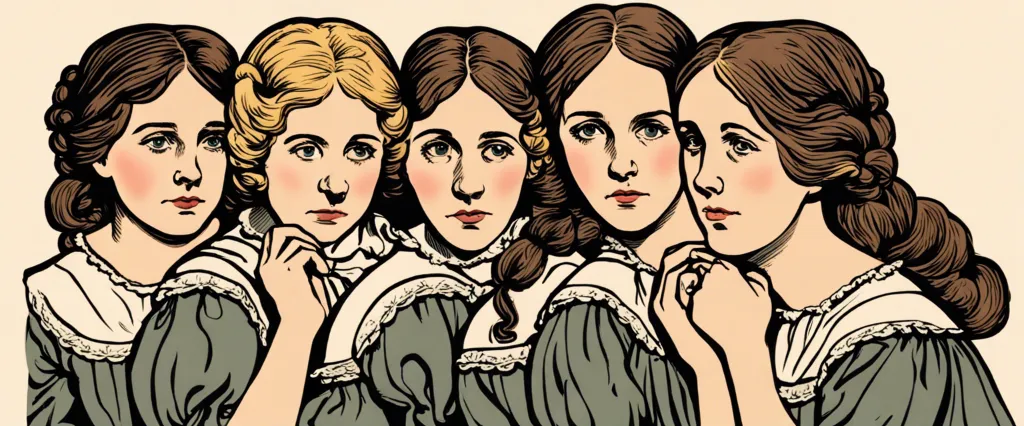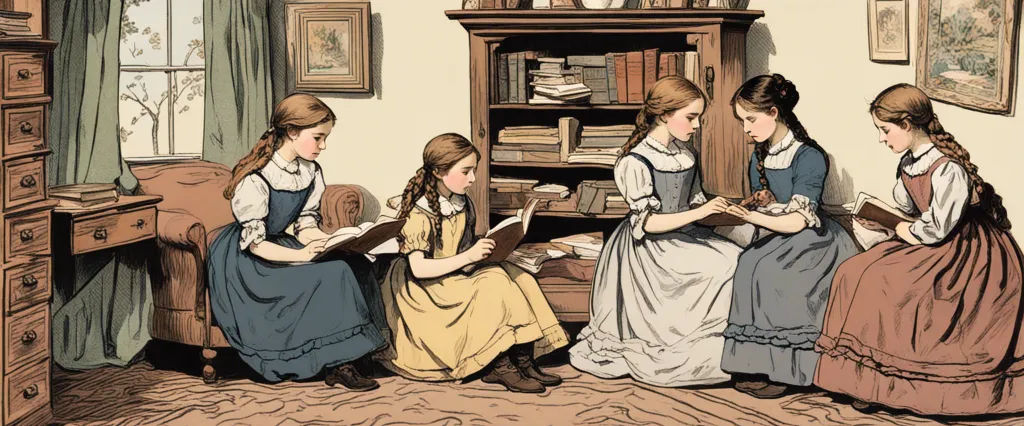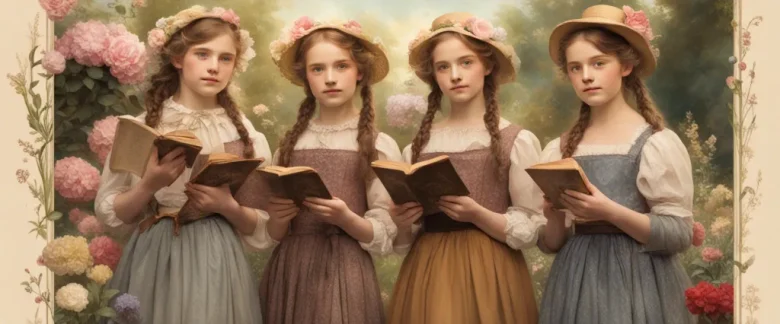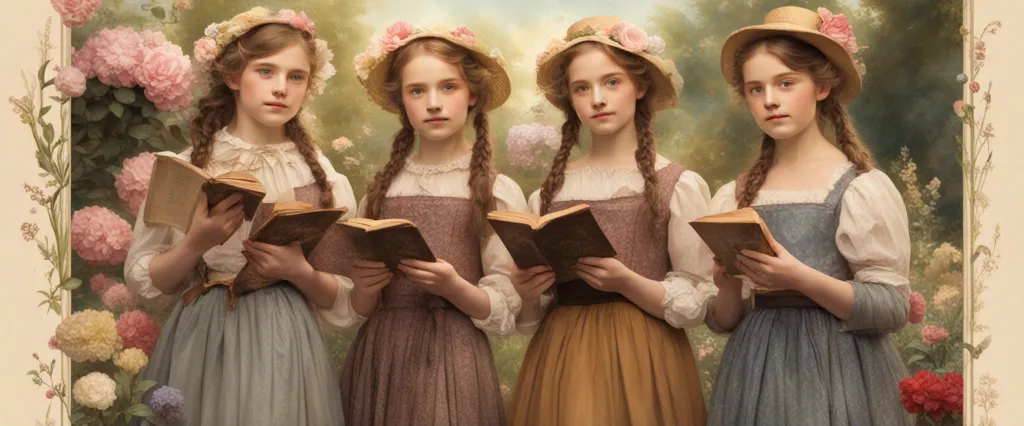“Little women” by Louisa May Alcott is a timeless coming-of-age novel that follows the lives of the four March sisters – Meg, Jo, Beth, and Amy, as they navigate the challenges and joys of growing up in Concord, Massachusetts during the Civil War. Written in 1868, Alcott’s novel captures the essence of sisterhood, family, love, and personal growth. As a prominent American author of her time, Louisa May Alcott was not only an accomplished writer but also an advocate for women’s rights, reflecting her own experiences and beliefs through her beloved characters.
Chapter 1: The March Sisters’ Childhood
Chapter 1: The March Sisters’ Childhood of Little Women by Louisa May Alcott introduces the readers to the four March sisters and their life in a modest New England town during the Civil War era. The chapter starts with the description of the March family’s dwelling – a quaint house called “Orchard House.” Here we meet the four sisters: Meg, Jo, Beth, and Amy.
Meg, being the eldest, is portrayed as beautiful and responsible. Jo, the second sister, is the tomboyish and ambitious one, always immersed in her writing. Beth, the third, is shy and a lover of music, always shyly by her mother Marmee’s side. Lastly, there’s Amy, the youngest and most artistic of them all.
As the chapter unfolds, we witness the girls engaging in a range of activities that portray their distinct personalities. They play, learn, and support one another as they navigate the challenges of life. We learn about their father being away, serving as a chaplain in the war, and their mother being a source of comfort and wisdom.
One notable event in this chapter is a play that the girls put on for their mother’s amusement. They perform a scene from Shakespeare’s “A Midsummer Night’s Dream.” This act demonstrates their creativity and love for dramatics. Additionally, it shows their strong bond as sisters, as they gather together to provide joy and entertainment to their mother.
Overall, Chapter 1 sets the scene for a delightful tale of sisterhood, love, and self-discovery. It establishes the March sisters’ unique qualities, their relationship with their parents, and foreshadows the challenges and triumphs they will face in the coming chapters.
Chapter 2: Growing Up and Finding Love
Chapter 2: “Growing Up and Finding Love” of Louisa May Alcott’s novel “Little Women” continues the story of the March sisters, Meg, Jo, Beth, and Amy, as they navigate their teenage years and start to explore romantic relationships.
The chapter begins with Meg and Jo discussing their upcoming social season. Meg, being the oldest, is excited about attending parties and being introduced to potential suitors. Jo, with her independent spirit, is more focused on her writing and dismisses the idea of romantic relationships.
However, the sisters soon find themselves attending a neighbor’s party. Meg enjoys dancing and mingling with young men, receiving attention from rich neighbors Laurie Laurence and his tutor, John Brooke. Meanwhile, Jo spends her time socializing with Laurie and his grandfather, who had recently moved next door. Despite her initial resistance, Jo starts to develop a fondness for Laurie’s friendly and humorous nature.
Later in the chapter, the March sisters receive a letter from their father who is away serving in the Civil War. The letter brings both joy and worry as Mr. March shares his experiences and expresses his pride in his daughters. This letter becomes a reminder of the absence of their father and the sacrifices their family is making during the war.
Towards the end of the chapter, Meg agrees to accompany Mrs. Gardner, a wealthy friend, to an upcoming party. She hopes to secure an invitation for her family, giving them a taste of the luxuries they often lack. However, Meg’s excitement is dampened when she realizes that Jo’s disinterest in attending such events might paint her as a snob or prevent her from finding a suitable husband.
Chapter 2 of “Little Women” explores themes of coming of age and the complexities of love and relationships. It highlights the differences in the sisters’ attitudes towards romance and foreshadows the challenges they will encounter in their search for love and happiness.
Chapter 3: Trials and Tribulations
Chapter 3: Trials and Tribulations of “Little Women” by Louisa May Alcott picks up with the March sisters dealing with various challenges and learning important lessons along the way.
The chapter begins with the girls diving into their ambitious New Year’s resolutions, focusing on improving their attitudes, habits, and virtues. Meg, the eldest sister, vows to control her temper, while Jo, the second eldest, seeks to overcome her tendency to be “vain and ambitious.” Beth, the shy and gentle sister, aims to work on her shyness, and the youngest, Amy, resolves to improve her selfishness. These resolutions form the foundation for the characters’ personal growth throughout the novel.
Their trials and tribulations truly begin when Meg is invited to attend a glamorous party held by her wealthy friend, Annie Moffat. Meg longs to fit in and impress others, but she soon realizes that appearances and material possessions are not as important as genuine relationships and self-acceptance. This experience teaches her a valuable lesson about valuing her own worth and not succumbing to societal pressures.
Meanwhile, Jo faces her own challenge when she decides to cut off all her cherished long hair to fund a train ticket for her mother to visit their father, who is away at war. This sacrifice demonstrates Jo’s selflessness and love for her family. Moreover, it symbolizes her transition from girlhood to womanhood as she lets go of her attachment to her physical appearance.
Lastly, the chapter delves into the delicate relationship between Amy and Jo. After an argument, Amy longs to seek revenge by burning Jo’s manuscript, which Jo has worked on tirelessly. However, before Amy can carry out her plan, she falls through the ice while skating and nearly drowns. Jo, filled with guilt and remorse, saves her sister and realizes forgiveness is more important than revenge. This experience contributes to the development of both characters, teaching them the importance of love, forgiveness, and familial bonds.
In Chapter 3 of “Little Women,” the March sisters face various trials that test their values and teach valuable life lessons, shaping their characters and relationships as they navigate the challenges of growing up.
Chapter 4: Jo’s Independence and Ambitions

Chapter 4: Jo’s Independence and Ambitions of “Little Women” by Louisa May Alcott follows the independent and ambitious Jo March as she navigates her desire to be free from societal expectations and pursue her dreams of becoming a successful writer. The chapter starts with Jo trying to suppress her longing for her family’s acceptance of her unconventional ways. She decides to focus on her writing instead.
Jo becomes friends with Laurie, the boy who lives next door, and they form a close relationship. They share their dreams and aspirations, and Laurie appreciates Jo’s fiery spirit and independence. Jo introduces Laurie to her beloved “castle in the air,” where they bond over imagined adventures and artistic pursuits.
Despite the societal pressures on girls to prioritize marriage, Jo vehemently rejects the idea. She does not want to be tied down to a traditional life and is determined to become a successful writer, like her literary idols. Jo’s ambition is fueled by her desire for independence and her yearning to support her family financially.
However, sometimes Jo’s ambitions clash with her loving heart. She struggles with feeling guilty for not conforming to traditional gender roles and wonders if her unconventional choices will disappoint her family. Yet, within her, there is a fire that refuses to be extinguished, pushing her to pursue her dreams fiercely.
Chapter 4 exemplifies Jo’s determination, independence, and her unwavering ambition to defy societal norms. It also highlights the deep bond she forms with Laurie and her conviction to pursue her passion for writing, despite the challenges she may face.
Chapter 5: Beth’s Quiet Strength
In Chapter 5 of “Little Women” by Louisa May Alcott, titled “Beth’s Quiet Strength,” the focus shifts to Jo’s youngest sister, Beth. Beth is often described as the most quiet and gentle of the March sisters and possesses an extraordinary capacity for kindness. This chapter explores her relationship with the Laurence family and their son, Laurie.
Beth spends a significant amount of time at the Laurences’ home, playing the piano and engaging in heartfelt conversations with Mr. Laurence, Laurie’s grandfather. Mr. Laurence recognizes Beth’s innate goodness and expresses his appreciation for her calming presence. Beth’s music reflects her sensitive nature and ability to find solace in playing the piano.
As the chapter progresses, it becomes evident that Beth’s compassionate spirit extends beyond her social interactions. She selflessly dedicates herself to caring for her family, especially her ailing mother. Beth diligently attends to her mother’s needs, providing comfort and support during her illness. Her presence brings a sense of calm and peace to their home, mirroring her earlier interactions with Mr. Laurence.
The chapter concludes with a heartwarming encounter between Beth and Laurie. Despite their differences in personality, Laurie admires Beth’s selflessness and genuine nature. This admiration leads to the formation of a deep and lasting friendship between the two.
Overall, Chapter 5 highlights Beth’s unique character and the profound impact she has on those around her through her quiet strength, kindness, and unwavering devotion to her family.
Chapter 6: Amy’s Artistic Journey
Chapter 6: Amy’s Artistic Journey of the book “Little Women” by Louisa May Alcott focuses on the artistic development of the youngest March sister, Amy. The chapter begins with Amy expressing her desire to become a great artist, inspired by her Aunt March’s collection of paintings and visits to art galleries.
Amy convinces her parents to allow her to take art classes, and she starts taking lessons from Mr. Davis, a young and talented art instructor. She is determined to prove herself as a skilled artist and devotes herself to her studies. However, Amy often becomes frustrated with her own limitations and feels discouraged when her classmates, particularly her friend, Kitty Bryant, produce better work.
Additionally, Amy’s vanity becomes evident when she desires a set of drawing pencils and watercolor paints, despite her family’s limited budget. When her request is denied, she resorts to borrowing materials from Kitty, much to her own embarrassment.
While Amy faces challenges and setbacks in her artistic journey, she refuses to give up. She continues to work hard and seeks improvement in her skills. Amy’s determination pays off when her perseverance is applauded by Mr. Davis, who recognizes her talents and praises her progress.
In this chapter, readers witness Amy’s growth both in skill and character. Her passion for art is evident, and she learns the value of persistence and patience in pursuing her dreams. Though faced with disappointments and envy towards others’ abilities, Amy’s journey reinforces the underlying theme of the novel, which highlights the importance of personal growth, self-discovery, and the fulfillment of one’s aspirations.
Chapter 7: Jo’s Transformation and Love
Chapter 7 of “Little Women” by Louisa May Alcott is titled “Jo’s Transformation” and explores the journey of the protagonist, Josephine “Jo” March, as she grows from a tomboy into a young woman discovering her own identity and passions.
In this chapter, Jo is thirteen years old and her family is celebrating the New Year. Jo secretly vowed to change her hot-tempered, impulsive ways and conquer her boyish behavior. She desires to become more refined like her older sister, Meg. Jo’s transformation is symbolized by her decision to cut off her long locks and embrace a shorter hairstyle, which was considered more appropriate for women during that period.
As the story progresses, Jo struggles to suppress her fiery personality and conform to society’s expectations. However, her efforts to change are tied to her love for her family, rather than seeking approval from others. The author emphasizes Jo’s compassionate nature, demonstrated through her care for her younger sisters, Beth and Amy, and her kind gestures towards her neighbors.
Furthermore, Jo’s transformation is also intertwined with her love for literature and writing. She aspires to be a famous author and dedicates her time to pen stories and plays. We witness her developing a strong preference for solitude and creativity, finding solace in her own world of imagination.
Despite her internal conflicts, Jo remains deeply loyal to her family and friends. She expresses her love through selfless acts and supports her sisters during their moment of vulnerability. This chapter serves as a pivotal point in Jo’s character development, as she begins to embrace her individuality and pursue her dreams with ardor and dedication.
In conclusion, Chapter 7 of “Little Women” highlights Jo’s transformation from a tomboy to a young woman who learns to balance societal expectations with her own passions and desires. Jo’s quest for self-improvement, love for her family, and her growing devotion to her creative pursuits are central themes that shape her character throughout the book.

Chapter 8: The March Sisters’ Future
Chapter 8: The March Sisters’ Future, in the book Little Women by Louisa May Alcott, explores the dreams and ambitions of the four March sisters as they embark on their journey into adulthood.
The chapter starts with Meg, the eldest sister, receiving an invitation to a fancy ball. She excitedly prepares for the event but, upon realizing that her dress is not as elegant as she had hoped, she grows disheartened. Her sisters, however, come to her rescue by giving her their own treasures to enhance her outfit. Meg attends the ball, where she is praised for her grace and beauty. This experience teaches her the value of self-worth and kindness over material possessions.
Meanwhile, Jo, the second eldest sister, focuses on her writing aspirations. She spends her time crafting stories and submitting them to various publishers, hoping to make a living from her passion. Jo faces numerous rejections but remains determined to pursue her dreams, finding solace in her supportive family.
Beth, the gentle and selfless sister, brings joy to the household through her music. She plays the piano for neighbors and charitable events, touching the hearts of all those who listen. However, her fragile health becomes a concern, and she slowly withdraws from society.
Lastly, Amy, the youngest, dreams of becoming a talented artist. She receives lessons from their wealthy neighbor, Laurie, and develops her artistic skills. However, her impulsive behavior leads to an incident where she accidentally burns Jo’s manuscript. Deeply regretting her actions, she seeks forgiveness and learns the importance of responsibility.
In this chapter, each sister faces her own challenges and grows in unique ways. They support and encourage each other, emphasizing the strength of their bond as they navigate their individual paths towards fulfilling their dreams and shaping their futures.
After Reading
In conclusion, “Little Women” by Louisa May Alcott is a heartwarming and timeless story that follows the lives of the four March sisters as they navigate through the challenges and joys of adolescence and early adulthood. Through their individual journeys of self-discovery and growth, the novel explores themes of sisterhood, love, and the pursuit of personal aspirations. Alcott’s beautiful writing style, relatable characters, and insightful observations about societal norms and gender roles make this book a beloved classic. It reminds readers of the importance of familial bonds, resilience, and the pursuit of one’s dreams, leaving a lasting impact on generations of readers.
1. “Anne of Green Gables” by L.M. Montgomery – This classic novel follows the adventures of Anne Shirley, an imaginative and outspoken orphan who is mistakenly sent to a middle-aged brother and sister who had intended to adopt a boy. Like “Little Women,” this book explores themes of friendship, growing up, and the struggles and joys of family life.
2. Pride and Prejudice” by Jane Austen – Set in early 19th-century England, “Pride and Prejudice” revolves around the Bennet family, particularly the romantic relationship between Elizabeth Bennet and Fitzwilliam Darcy. With its focus on strong-willed female characters, societal expectations, and the pursuit of love, this novel shares similar themes with “Little Women.”
3. To Kill a Mockingbird” by Harper Lee – This Pulitzer Prize-winning novel is set in the Deep South during the Great Depression and explores issues of racial inequality, discrimination, and moral growth through the eyes of Scout Finch, a young girl who learns valuable life lessons from her father, Atticus. Like “Little Women,” it delves into the importance of family, friendship, and the power of empathy.
4. “The Secret Garden” by Frances Hodgson Burnett – In this beloved children’s classic, a young girl named Mary Lennox discovers a hidden garden on her uncle’s estate, which serves as a metaphor for personal growth and emotional healing. With its emphasis on nature, self-discovery, and the transformative power of love, “The Secret Garden” shares common themes with “Little Women.”
5. Jane Eyre” by Charlotte Brontë – This Gothic novel tells the story of Jane Eyre, an orphaned governess who faces various challenges while seeking independence and love in the harsh Victorian society. Similar to “Little Women,” this book explores the development of a strong-willed female protagonist, the complexities of family relationships, and the pursuit of personal and emotional fulfillment.




